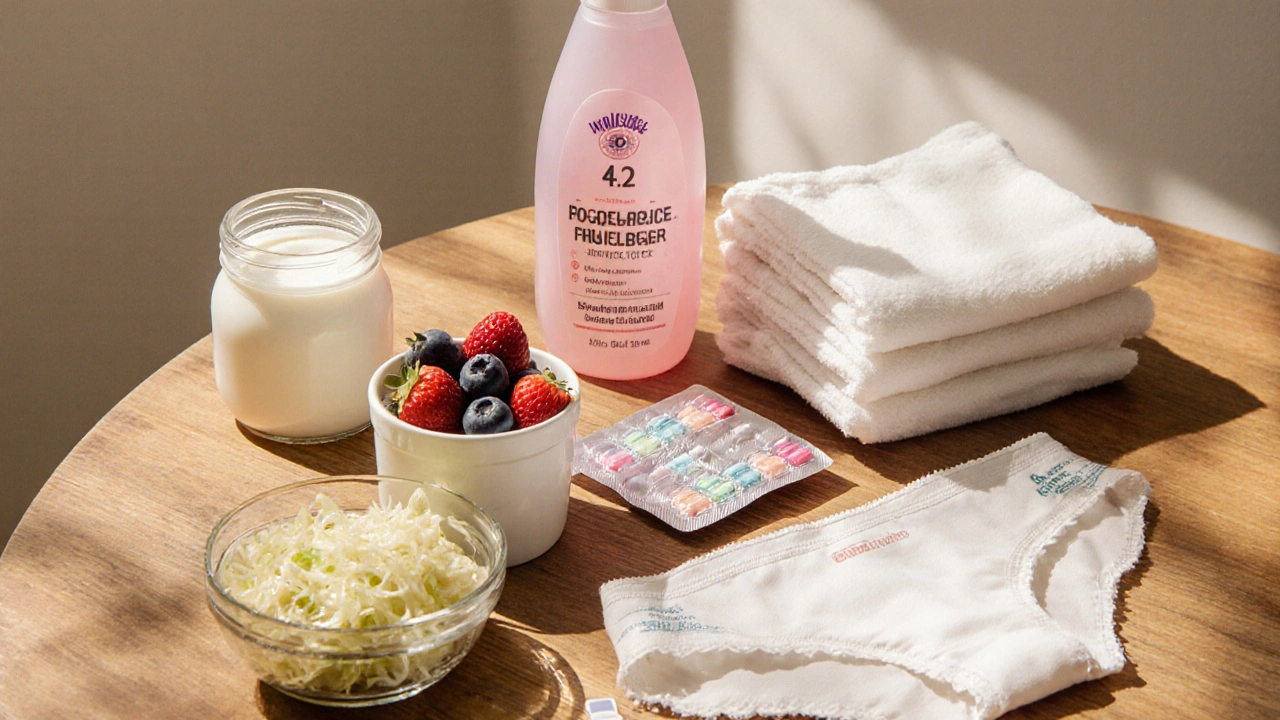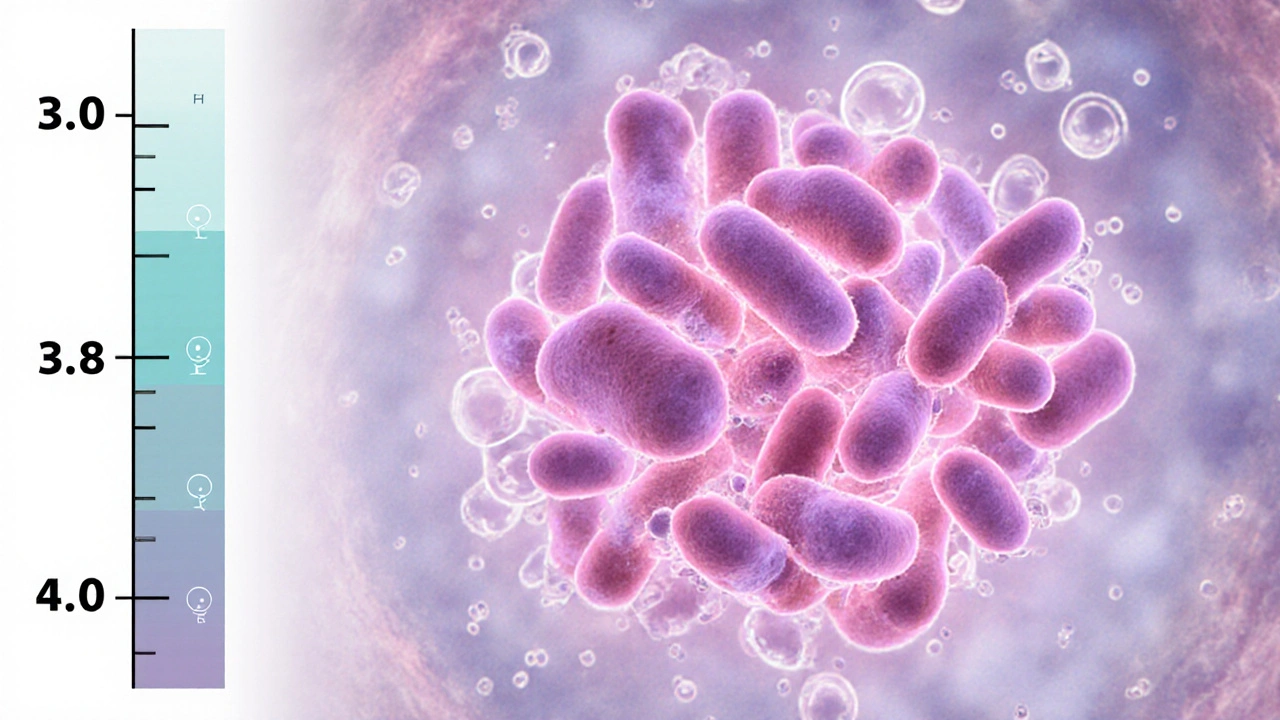Vaginal pH Balance Checker
About Vaginal pH Balance
The normal vaginal pH range is 3.8–4.5. This slightly acidic environment helps protect against harmful bacteria and yeast infections by supporting the growth of beneficial lactobacilli.
Enter your pH level and click "Check pH Status" to get results.
What to Do Next
- Normal Range (3.8–4.5): Maintain current habits and monitor regularly.
- Warning Zone (4.6–5.0): Review hygiene practices and consider consulting a healthcare provider.
- High Risk (>5.0): Seek medical advice for testing and treatment options.
Key Takeaways
- Normal vaginal pH (3.8‑4.5) creates an environment where good bacteria thrive and harmful microbes struggle.
- Lactobacillus species are the main protectors; they produce lactic acid that keeps pH low.
- Disruptors like douching, harsh soaps, antibiotics, and hormonal shifts can raise pH and invite infections.
- Simple lifestyle tweaks-use pH‑balanced cleansers, wear breathable fabrics, and consider probiotic foods or supplements-help restore balance.
- Early signs of imbalance (odd odor, itching, unusual discharge) should prompt a check‑up before an infection takes hold.
Maintaining a healthy vaginal pH balance is a cornerstone of vaginal health. When the acidic environment stays within its natural range, the vagina can fend off the most common culprits behind unpleasant infections.
Vaginal pH balance is the measure of acidity inside the vaginal canal, normally ranging from 3.8 to 4.5. This slight acidity is not random; it is the result of a thriving community of good bacteria that constantly produce lactic acid.
How pH Keeps the Bad Guys Out
The vagina hosts a complex ecosystem. The star players are Lactobacillus, a group of friendly microbes that produce lactic acid, hydrogen peroxide, and other antimicrobial substances. Their work keeps the pH low enough that pathogens such as Bacterial vaginosis (BV) and yeast infection (candidiasis) struggle to grow.
When lactobacilli dominate, the environment remains acidic, moisture‑rich, and inhospitable to anaerobic bacteria that cause BV, as well as to Candida albicans, the yeast behind most infections.

Common Triggers That Tilt the Scale
Several everyday habits can push the vaginal pH upward, weakening its natural defenses:
- Douching: Rinsing the vagina with water, scented solutions, or antiseptics removes beneficial bacteria and introduces alkaline substances.
- Harsh soaps and detergents: Many feminine washes have a pH near neutral (7), which can neutralize the vagina’s acidity.
- Antibiotics: Broad‑spectrum antibiotics kill both harmful and helpful bacteria, often leading to a temporary drop in lactobacilli.
- Hormonal changes during menstruation, pregnancy, or menopause alter the microbial balance and can raise pH.
- Synthetic fabrics: Tight, non‑breathable underwear traps moisture and heat, creating a breeding ground for unwanted microbes.
Each of these factors can shift the pH from its optimal 3.8‑4.5 range up toward 5.0 or higher, at which point BV or a yeast infection becomes much more likely.
Spotting an Imbalance Early
Early warning signs often appear before a full‑blown infection develops:
- Thin, grayish discharge with a fishy odor-classic for BV.
- White, clumpy discharge accompanied by itching-typical of a yeast infection.
- Increased irritation or a burning sensation, especially after sex or exercise.
Paying attention to these cues lets you act quickly-whether that means swapping products, adjusting diet, or seeing a clinician for a pH test.
Practical Ways to Keep pH in Check
Below are evidence‑based habits that actively support a healthy vaginal environment:
- Choose a gentle, pH‑balanced cleanser (around 4.0‑4.5). Avoid scented soaps and wipes.
- Wear breathable cotton underwear and avoid tight leggings for long periods.
- Limit douching entirely; the vagina cleans itself naturally.
- If you need to take antibiotics, ask your doctor about a probiotic supplement that contains Lactobacillus crispatus or Lactobacillus rhamnosus. Clinical studies show these strains help restore the normal flora within 2‑3 weeks.
- Incorporate fermented foods-yogurt, kefir, sauerkraut-into your diet. The live cultures can repopulate the gut and, indirectly, the vaginal microbiome.
- Stay hydrated and maintain a balanced diet rich in prebiotic fiber (e.g., bananas, onions, garlic) to feed good bacteria.

When to Seek Professional Help
If symptoms persist beyond a few days, or if you experience recurrent infections (more than three per year), it’s time to see a healthcare provider. They can perform a simple pH test using a litmus strip and a microscopic exam to identify the exact cause.
Treatment may involve prescription antibiotics for BV, antifungal medication for candidiasis, or a tailored probiotic regimen to rebuild the lactobacilli population.
Comparison: Normal vs Disrupted Vaginal pH
| Aspect | Normal (3.8‑4.5) | Disrupted (≥5.0) |
|---|---|---|
| Dominant microbes | Lactobacillus spp. | Gardnerella, Candida, & other anaerobes |
| Typical symptoms | None or mild itching after intercourse | Fishy odor, abnormal discharge, itching, burning |
| Risk of infection | Low | High (BV, yeast infection, UTIs) |
| Common triggers | Balanced diet, breathable fabrics | Douching, antibiotics, harsh soaps, hormonal shifts |
FAQs
What is the normal vaginal pH range?
A healthy vagina typically measures between 3.8 and 4.5 on the pH scale. This slightly acidic environment is essential for keeping harmful bacteria at bay.
How do lactobacilli protect against infections?
Lactobacillus species produce lactic acid, hydrogen peroxide, and bacteriocins. These compounds lower the pH and directly inhibit the growth of pathogens like Gardnerella vaginalis (BV) and Candida albicans (yeast).
Can douching really cause infections?
Yes. Douching removes the protective lactobacilli and can introduce alkaline fluids that raise pH. Studies consistently link regular douching with a higher incidence of BV and yeast infections.
Do antibiotics disrupt vaginal pH?
Broad‑spectrum antibiotics kill both harmful and beneficial bacteria. After a course, lactobacilli may be depleted, allowing pH to rise and infections to appear. A probiotic supplement can help restore balance.
Are probiotic supplements effective for vaginal health?
Clinical trials show that strains like Lactobacillus rhamnosus GR-1 and Lactobacillus reuteri RC-14 can recolonize the vagina, lower pH, and reduce recurrence of BV and yeast infections when taken daily for at least 30 days.






Written by Martha Elena
I'm a pharmaceutical research writer focused on drug safety and pharmacology. I support formulary and pharmacovigilance teams with literature reviews and real‑world evidence analyses. In my off-hours, I write evidence-based articles on medication use, disease management, and dietary supplements. My goal is to turn complex research into clear, practical insights for everyday readers.
All posts: Martha Elena